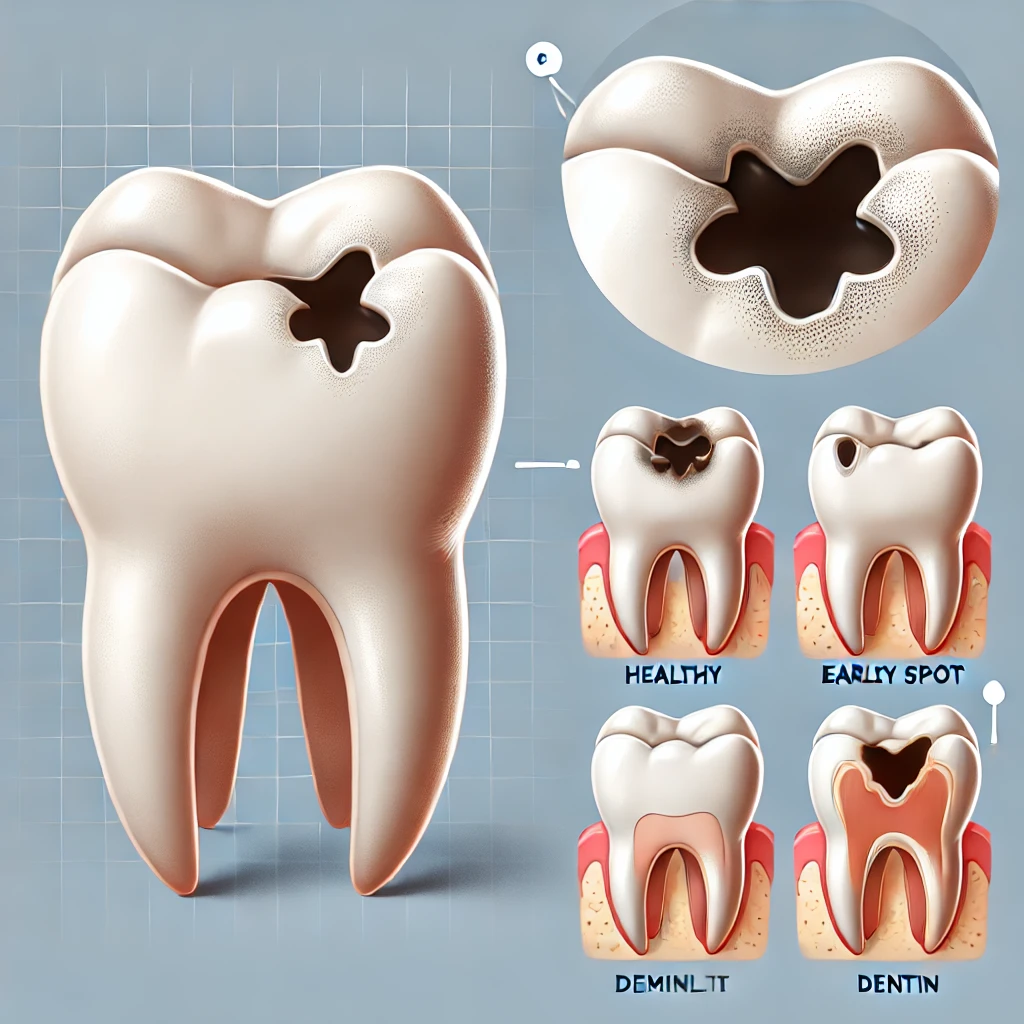What Does a Cavity Look Like? A Detailed Guide to Recognizing Tooth Decay
Cavities, also known as dental caries, are one of the most common dental problems worldwide. They occur when bacteria in the mouth produce acid that eats away at the enamel (the outer layer of the tooth) and can eventually affect deeper layers. Recognizing the early signs of a cavity is essential to prevent further damage to your teeth and maintain oral health.
In this guide, we’ll take a closer look at what cavities look like in various stages, how they form, and what to do if you suspect you have one.
1. What Causes a Cavity?
A cavity is the result of tooth decay, which typically occurs when sugars and starches from foods and drinks are left on the teeth. Bacteria in the mouth feed on these sugars and produce acids that wear down the tooth enamel over time. If left untreated, the acid can penetrate deeper into the tooth, affecting the dentin (the softer layer beneath the enamel) and potentially reaching the pulp, which contains nerves and blood vessels.
2. What Do Early Cavities Look Like?
In the early stages of a cavity, it may not be easy to see with the naked eye, but there are subtle signs to watch for:
- White Spots: One of the first visual signs of a cavity is a white spot on the tooth. This indicates that the enamel is starting to lose minerals, which weakens the tooth and makes it more susceptible to decay. These white spots may be dull and chalky in appearance, contrasting with the rest of the tooth’s smooth surface.
- Rough Texture: If you run your tongue over the affected area, it may feel rough or uneven compared to the surrounding tooth surface. The enamel starts to break down, creating small pits or rough patches.
3. Visible Signs of Tooth Decay
As the cavity progresses and more of the enamel is destroyed, the damage becomes more visible:
- Brown or Black Spots: Over time, a cavity may become more noticeable as it turns into a brown, dark gray, or black spot on the tooth. These spots often develop on the biting surfaces of molars, between teeth, or along the gumline. The discoloration occurs as decay progresses and the tooth structure begins to break down.
- Small Holes: Cavities can also appear as small pits or holes in the tooth surface. These holes are a clear sign that decay has progressed beyond the outer layer of enamel and is now affecting the deeper layers of the tooth. You may be able to see or feel these holes with your tongue.
4. Advanced Cavity Appearance
If left untreated, a cavity can worsen, leading to more severe damage. In advanced stages, a cavity can be large, painful, and affect the overall function of the tooth:
- Larger Holes or Craters: At this stage, the cavity will create a visible hole in the tooth that may appear as a deep crater. The decay will have eroded both the enamel and dentin, leaving the tooth fragile and vulnerable to further damage.
- Tooth Sensitivity or Pain: When the cavity reaches the dentin or pulp, you may experience sensitivity or pain, especially when eating hot, cold, or sweet foods. The tooth can also appear broken or chipped due to weakened enamel.
- Abscess Formation: In the most severe cases, if the decay reaches the pulp, an infection can develop, leading to the formation of an abscess at the base of the tooth. This abscess may look like a swollen, red, or pus-filled area on the gums near the affected tooth.
5. Hidden Cavities: Between Teeth
Cavities don’t always form on the visible surface of a tooth. They can also occur between teeth, making them harder to detect without the help of a dentist. These interproximal cavities can cause damage before you notice any symptoms. Dentists typically identify these cavities during regular check-ups with the use of X-rays or other diagnostic tools.
6. Other Signs and Symptoms of Cavities
While the visual appearance of a cavity is important, you may also notice the following symptoms:
- Tooth Sensitivity: Pain or discomfort when eating or drinking hot, cold, or sugary foods is a common early sign of tooth decay.
- Bad Breath: Persistent bad breath or a bad taste in your mouth can be caused by bacteria thriving in the decayed tooth.
- Toothache: A sharp or throbbing toothache, especially when biting down, indicates that the cavity may have progressed to the nerve.
7. How to Prevent Cavities
The best way to deal with cavities is to prevent them from forming in the first place. Here are some key strategies for cavity prevention:
- Brush twice a day: Use fluoride toothpaste to help strengthen enamel and protect teeth from decay.
- Floss daily: Cleaning between your teeth helps remove plaque and food particles that contribute to cavities.
- Regular dental check-ups: Visiting the dentist every six months allows for early detection of cavities and proper treatment.
- Limit sugary foods and drinks: Reducing your intake of sugary snacks, sodas, and sticky foods can lower the risk of cavities.
Conclusion: Recognizing a Cavity
Cavities can take on many forms depending on the stage of tooth decay. Early cavities might appear as white spots, while more advanced decay can show as dark spots, holes, or even cause toothache. Paying attention to your oral health and regularly visiting the dentist can help you catch cavities early before they worsen.
If you notice any changes in your teeth, such as discoloration, sensitivity, or holes, schedule a visit to your dentist. Addressing a cavity early can prevent pain, extensive dental work, and possible tooth loss. Maintaining a good oral hygiene routine is key to keeping your teeth healthy and cavity-free.






